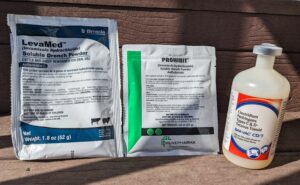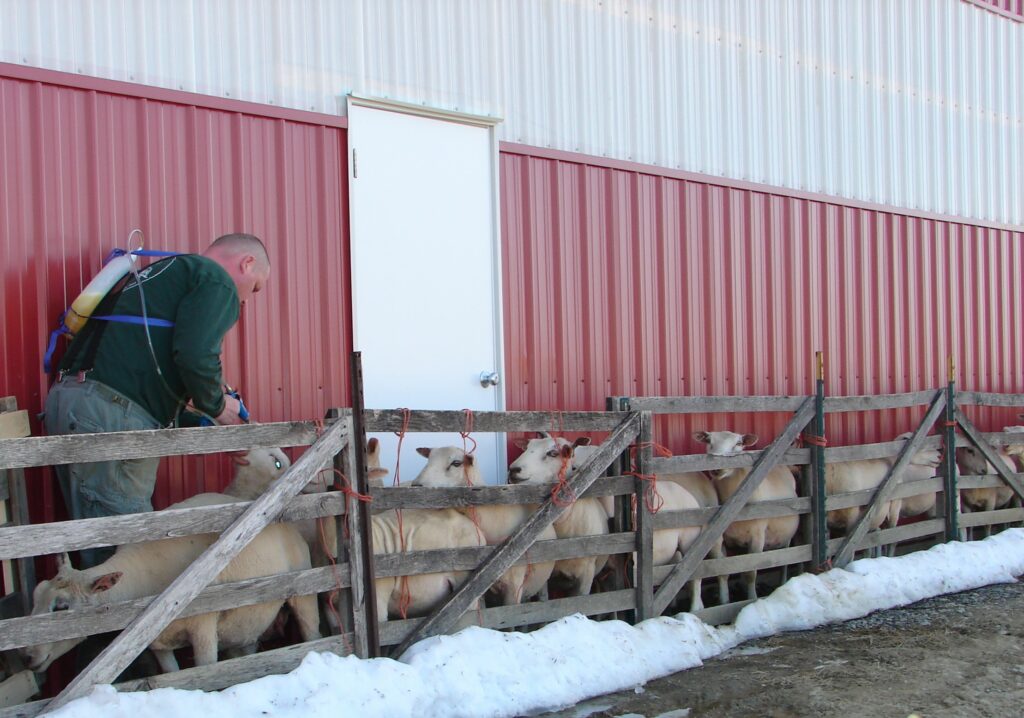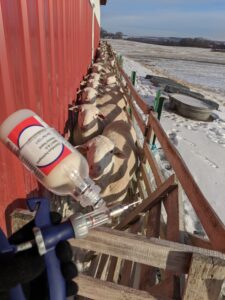Why Sheep Die
There are two leading causes of death for sheep, according to this farmer’s experience.
Selling young White Dorper breeding stock inevitably brings the expected follow-up calls when buyers have questions after the purchase. This is especially true when a new sheep farmer ran into problems and a sheep dies. While sheep can die of many causes, over the years I have filtered out two leading causes of death. It so happens that both can be easily remedied but an effort must be taken.
The first leading cause of death is the barber pole worm (Haemonchus contortus). It thrives in a humid climate. Sheep in arid climates are not as affected by it but my customer base farms exclusively in areas with a humid climate. Among the many internal parasites sheep can contract, none is as frequently deadly as this worm. Its appearance resembles old-fashioned barber poles, hence the common name. Its larvae get ingested when grazing, pass through the first three stomach chambers, and the worms then develop in the fourth and actual stomach(abomasum)of the sheep. There, they live by the thousands and suck the blood of the sheep, causing anemia and eventually death. Young animals less than one year old are particularly susceptible to it; so are ewes right after lambing since their immune system is weakened after lambing. Adult ewes at other times of the year and especially adult rams have often developed enough resistance and are not as much in danger of dying.
Prevention isa big part of managing the barber pole worm since you will not be able to get rid of it from your pasture. Leaving enough residual of approximately four inches in a rotational grazing system is one of the remedies since most of the larvae do not go upon the plants for more than four inches. A frequent pasture shift helps avoid grazing the pasture below these four inches or even close to the ground. To be clear, leaving residual in a rotational grazing system does not at all prevent an infestation with larvae but it does reduce it greatly compared to set-stock grazing practices, which inevitably will lead to grazing the pasture too short.
Tannins found in some plants like birdsfoot trefoil or copper oxide boluses may help with the prevention of the worm because they inhibit the fertility of this parasite.
Adult animals in any given flock that seem to be repeatedly affected by the barber poleworm while others aren’t, should be culled. Sheep that seem to be less affected may be more prone to building resistance. They may pass this ability to develop resistance onto their offspring.
Observation is a great tool to identify those animals that are affected by this parasite. When the pasture shift takes place, I always observe for the first few minutes if all sheep are grazing vigorously when entering the new grazing cell. An animal affected by a high infestation of the barber pole worm is likely to come towards the end of the flock, will eat listlessly, will lie down, and will look “sad”. Catching the sheep (as stress free as possible) and checking color of the eye mucous membrane, commonly referred to as eye lid color, will tell you if the sheep is suffering from such infestation. If the color is a solid pink or red, the barber pole worm is not the cause for the sheep’s sickness. If it is pale or even white, the barber pole worm is about to kill this animal. If you are new to it or if you have no reference point, you can familiarize yourself with the FAMACHA scorecard. It is a great tool for the inexperienced to determine if there is anemia present and the degree of anemia.
Another sign that may occur when a sheep is affected by the barber pole worm is the so-called bottle jaw, a swelling under the lower jaw. However, it does not always develop.

LevaMed and Prohibit dewormer (left) and
enterotoxemia/tetanus vaccine (right).
Remedy: No natural or alternative dewormers have been proven to kill the worms. Only chemical dewormers (anthelmintics) will do that. However, not all anthelmintics are equally effective because this worm has an amazing ability to develop resistance against dewormers. I have repeatedly read that resistance against Levamisole (brand names Prohibit and LevaMed), a dewormer that has been on the market for a long time, builds slower than against other dewormers, most notably compared to Ivermectin. It is true on my farm. After decades, Levamisole, coming in form of an“inconvenient” powder, that needs to be mixed with water and then given orally, is still effective in my flock. Caution is warranted with Cydectin, which belongs to the group of anthelmintics called Moxidectin, which is similar to Ivermectin. Resistance against it is likely going to build faster than resistance against Levamisole. I do not use any“white” dewormer (Valbazen, Safe-Guard, or Synanthic) to control barber pole infestations for the same reason I do not use Ivermectin: because of their ineffectiveness due to widespread resistance.
The deworming protocol matters a lot to extend the effectiveness of any dewormer. Deworming the entire flock in regular intervals is not advisable. While it may be prudent to deworm all ewes after lambing or all lambs at a young age, any additional deworming should be done on an as-needed basis. That may require checking the eyelid color for a healthy color and deworming those only that have a pale or white eye mucous membrane. Please note, this approach only works for this particular worm, the only one that causes anemia. All other worms do not influence the color of the mucous membrane.

Administering an oral dewormer.
Stool samples are always recommended before any deworming to determine the need for deworming and which dewormer is still effective. The result for any given flock as far as effectiveness of dewormers is concerned may in fact differ from what I state in my article. I feel compelled to mention this although I don’t practice what I just preached. Taking stool samples and having them evaluated for egg count and effectiveness of a dewormer is often time sensitive. However, having it done can be cumbersome, lengthy, and loaded with bureaucracy for some or not at all obtainable for others. That is why I have given up on it. Consider yourself blessed if this is a realistic and workable option for you. Use it.
When a lamb or sheep is affected by the barber pole worm and the infestation is identified early through thorough daily observation, you are likely able to save the animal when you deworm it immediately with an effective dewormer. That is entirely different with Enterotoxemia, also called overeating disease or sudden death disease. There the first sign of the disease is very often, you guessed it, death. Thorough observation will most often not help you in saving affected animals.
Enterotoxemia is caused by bacteria called Clostridium perfringens. There are different types of clostridia, type C and D being the common ones that cause the disease in sheep. It can be found in the soil and is always present in the intestines of a sheep. During times of intake of feed that is high in nutrients–either feeding grain or grazing lush pasture in the spring–the bacteria grow rapidly and release toxins. These toxins kill. In any given flock, the bigger and meatier sheep are more likely to die of overeating disease because they consume more feed, and thus more bacteria can grow, which release more toxins. It can also affect lambs while they are nursing. In such cases enterotoxemia is called pulpy kidney disease.It is called that way because the kidneys will lose their structure and firmness and will get mushy or “pulpy”.
Treatment is often unsuccessful if sheep is ill simply because first signs are easily missed, and death often comes within hours. Even if signs are detected and correctly diagnosed, treatment is often unsuccessful. Of course, all healthy animals of a flock can be treated at the time of some animals developing overeating disease. (This common term is a bit misleading since the animals are not actually overeating). You can either inject antibiotics like penicillin or oxytetracycline or you can inject antitoxins, a very costly option.

Vaccinating the ewes against Enterotoxemia and Tetanus prior to lambing.
The best strategy to avoid enterotoxemia is to vaccinate against it. While no vaccine is one hundred percent effective, it will reduce the number of deaths to the occasional ewe or lamb. The initial vaccination of lambs requires two shots about three to four weeks apart at an age of several weeks. After that, an annual booster shot is required. I give that booster shot to my ewes about four to six weeks before lambing. This way the lambs will take in antibodies through the milk they nurse from their mothers for the first few weeks of their lives until they themselves will get vaccinated.
It is advisable to use a combined enterotoxemia and tetanus vaccine, simply because tetanus is another disease that rarely can be treated successfully. The label will indicate the combination, usually in form of C/D and T. The C and D stand for the types of Clostridium perfringens and theT stands for tetanus. The most common and readily available vaccine is called Bar-Vac CD/T. There may be other manufactures producing this vaccine, but I am unaware of one offering this particular combination.
Opponents to the vaccine or vaccinations in general often claim that the vaccine itself has killed some of their sheep. I can’t say if stressful handling or poor condition of these sheep that died contributed to the death rather than the vaccine itself. I can speak for myself and state unambiguously that I have vaccinated thousands and thousands of sheep over the course of several decades and never once had a sheep or lamb falling ill, let alone die from it. Of course, my sheep are healthy and well-fed, and my handling is as stress free as it can be. However, I can attest to it that stressful handling can indeed end the life of a sheep with underlying causes.

